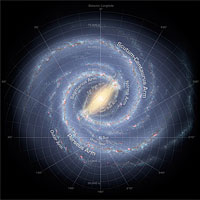3-in-1 Alternative Energy Car DIY STEM Kit
$19.99$14.95
Posted on: Jul 8, 2008

We live in the Milky Way galaxy - a disk-shaped collection of about 400 billion stars including the Sun. Many of those stars and much of the dense gas between the stars concentrate into large arms that spiral outward from the galactic center.
Astronomers have worked for decades to map the Milky Way and its spiral arms. They have just discovered a new spiral arm on the far side of the galactic center from Earth, which is a virtual twin of a known arm on the near side of the galactic center. The Milky Way therefore shows a beautiful symmetry, with two matching spiral arms lazily spinning near the galaxy's center.
Tom Dame of the Harvard-Smithsonian Center for Astrophysics (CfA) presented this finding today in a press conference at the 212th American Astronomical Society meeting.
'Our galaxy isn't as messy as many thought. What we have found is evidence of some balance and order, like the yin and yang of Chinese philosophy,' said Dame.
The Milky Way has other, larger spiral arms farther out in the galactic disk. This study focuses on the two arms closest to the center of the galaxy.
A 50-year puzzle solved
Fifty years ago, radio astronomers found an unusual spiral arm about 10,000 light-years from the center of the Milky Way along our line of sight. They called it the expanding 3-kiloparsec (3-kpc) arm since 3 kpc equals 10,000 light-years, and it was found to be expanding away from the center at more than 50 kilometer per second. The expanding 3-kpc arm contains about 10 million sun's worth of gas, mostly hydrogen atoms and molecules.
They suspected a similar arm might exist on the far side of the Milky Way, since many other galaxies tend to be symmetrical. But for decades, they were unable to find any evidence for a far-side counterpart of the expanding 3-kpc arm. One reason is that the galactic center is so crowded, with many different hydrogen gas clouds overlapping the same patch of sky.
'Studying the galactic center is like listening to a conversation in the middle of a crowded cocktail party. There's lots of noise,' said Dame's CfA colleague Patrick Thaddeus.
Dame and Thaddeus analyzed data obtained using a 1.2-meter-diameter millimeter-wave telescope located at Cerro Tololo Inter-American Observatory in Chile.
When Dame processed the data to highlight large-scale structures very close to the plane of the galaxy, a new feature jumped out at him. The data clearly showed a spiral arm exactly where the far 3-kpc arm should be, with properties like radius, expansion velocity, mass, and brightness that were mirror images of the near 3-kpc arm.
Spiral arms and galactic bar linked
Dame and Thaddeus suspect that the 3-kpc spiral arms are linked to the galactic bar. At the center of the Milky Way, billions of stars inhabit an elongated conglomeration called a stellar bar, which extends for several thousand light-years on either side of the galactic center. As that central bar rotates, it produces large-scale shock waves that likely sculpt the 3-kpc spiral arms and power their outward motions. In fact, theorists believe that those spiral arms connect to the ends of the bar.
'The 3-kiloparsec arms are a natural result of the stellar bar,' explained Thaddeus. 'We expected that the bar should drive symmetric structure. Now, we have proof that it does.'
Dame and Thaddeus confirmed their discovery using 21-centimeter radio measurements of atomic hydrogen collected by colleagues in Australia. Next, they plan to apply for observing time on the Robert C. Byrd Green Bank Telescope to examine the 3-kpc spiral arms in more detail. They also want to extend their observations to greater galactic longitudes as seen from Earth.
'We want to see how far we can chase these arms - hopefully to their origins at the ends of the central bar,' said Dame.
Headquartered in Cambridge, Mass., the Harvard-Smithsonian Center for Astrophysics (CfA) is a joint collaboration between the Smithsonian Astrophysical Observatory and the Harvard College Observatory. CfA scientists, organized into six research divisions, study the origin, evolution and ultimate fate of the universe.
 'The difference between what the most and the least learned people know is inexpressibly trivial in relation to that which is unknown.'
'The difference between what the most and the least learned people know is inexpressibly trivial in relation to that which is unknown.'